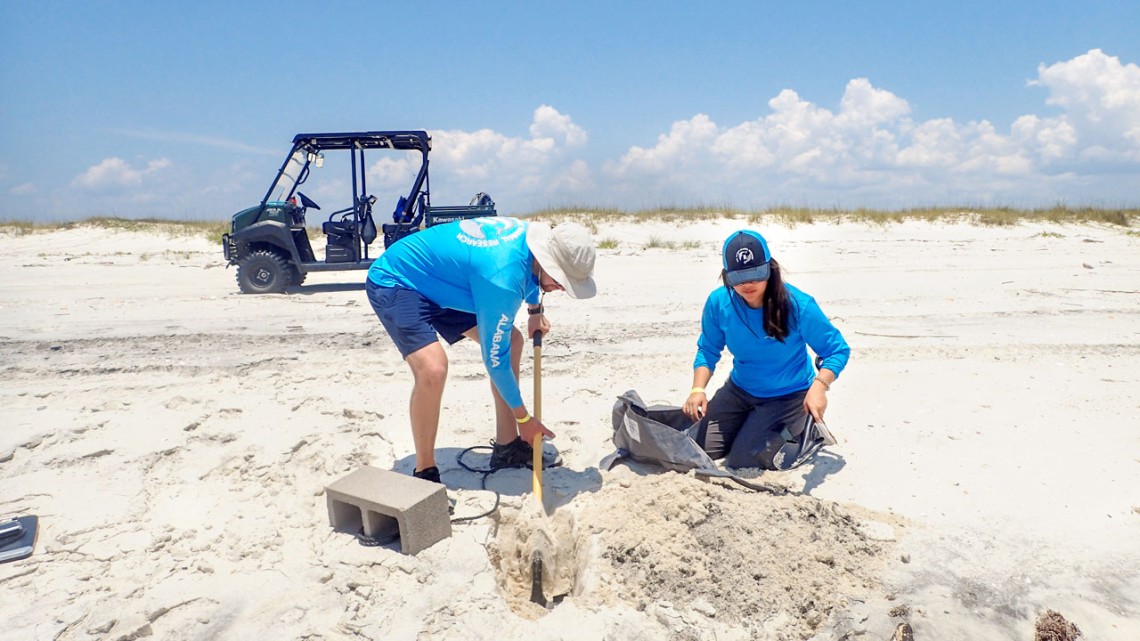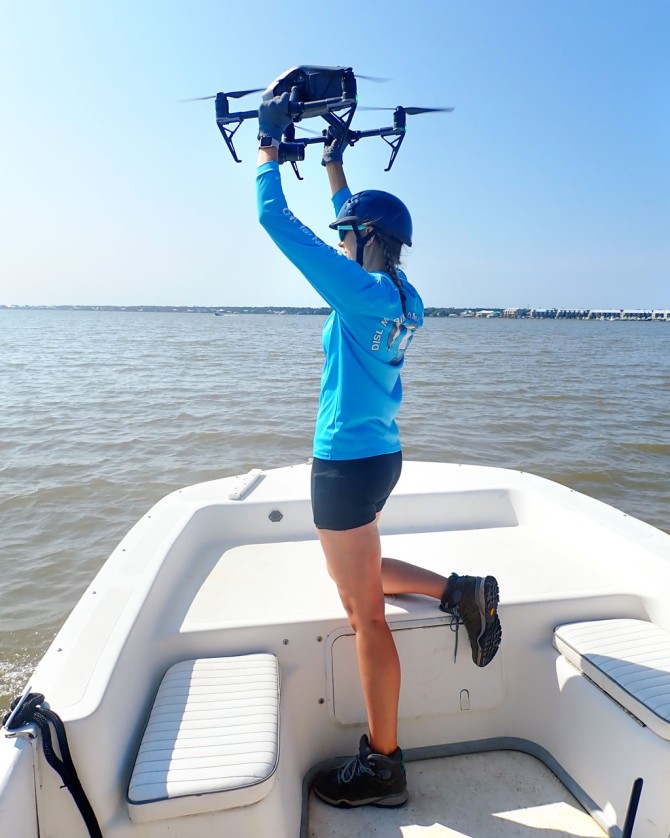
Staff at the Dauphin Island Sea Lab fill a dolphin decoy with sand.
Decoy carcasses reveal how often stranded dolphins are found
By Krishna Ramanujan, Cornell Chronicle
Better surveillance of marine mammals that wash up on beaches and in marshes will provide more accurate estimates of how many individuals of many species are dying and the causes of those deaths, according to a new study published Sept. 4 in Marine Mammal Science.
In the study, which took place on Dauphin Island, Alabama, the researchers planted decoys of bottlenose dolphins – a common marine mammal in the area – on popular and isolated beaches, and in remote and more trafficked marsh areas. The decoys were tagged with a phone number to call when a member of the public happed upon one.
The experiment gave researchers data on the rates at which stranded dolphins are found and reported, and identified areas where fewer decoys were detected – such as remote marsh areas – that may merit extra scrutiny by trained observers.
“How many people are reporting the animals is really important, because stranding networks rely on the public as their primary source of information for stranded animals,” said Dr. Jennifer Bloodgood, the paper’s corresponding author and assistant professor of practice at the Department of Public and Ecosystem Health in the College of Veterinary Medicine.
“The public only found 58% of the decoy dolphins overall, so that tells us a lot about the potential real number of actual stranded dolphins,” she said. For example, for every 100 dolphins found, according to the detection rate, there may be close to twice as many that strand but don’t get reported, she said.
“The study tells us about the cryptic mortality and where we should put efforts for doing more dedicated searches,” she said.
Marine mammals wash up on shores for many reasons, but the majority of cases in Alabama are due to human interactions, often drownings after being caught in equipment such as fishing nets. Dolphins, for example, are known to follow fishing vessels to catch easy prey in the nets. Infectious disease is another common cause of death, Bloodgood said.
In the study, Bloodgood and colleagues recruited help from the Department of Theater and Dance at the University of South Alabama to make 12 dolphin decoys using cloth and environmentally friendly materials. The decoys were about 3 feet long, the size of a baby dolphin, and fitted with zippers so they could be filled with sand, as well as loops for anchoring.
Decoys were then placed, three per four different habitats; at popular and less-popular beaches and marsh areas, during a peak tourist time and during the off-season. Each decoy was numbered and fitted with a sign that informed people to report the sighting, but also to leave the decoy in place.
A team of trained observers from the Alabama Marine Mammal Stranding Network at the Dauphin Island Sea Lab also searched over two-hour windows, so their results could be compared with the public reports. Staff members – who normally lack time to conduct such searches – walked or used kayaks, ATVs and drones.
The results revealed that the public found half the decoys in the off-season and two-thirds in the peak season, and they only found 17% of the decoys in low-trafficked marsh areas. Trained staff found three-fourths of the decoys in the off-season and 83% of them during the peak season. Use of the drone proved slightly better overall than the traditional (walking, ATV and kayak) methods, though some decoys were found by walking that weren’t seen by the drone, highlighting the importance of a mix of techniques.
Bloodgood said the findings are important because they point to habitats – such as less-frequented marsh areas – where staff members might focus their limited time and resources. “And, it’s important because we need to have better estimates of the total number of animals that are dying to really understand the effects of a specific cause of death,” Bloodgood said. “If we don’t know how many animals are stranded in the first place, it makes it difficult to try and estimate and extrapolate deaths to larger population numbers.”
Co-authors included researchers and staff at the Dauphin Island Sea Lab and the University of South Alabama.
The study was funded by the National Marine Fisheries Service.
Media Contact
Get Cornell news delivered right to your inbox.
Subscribe


